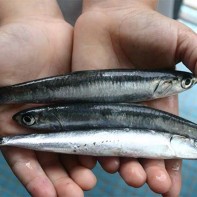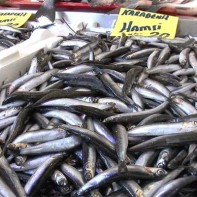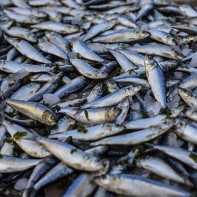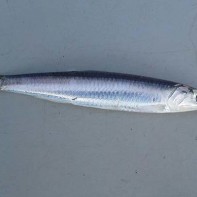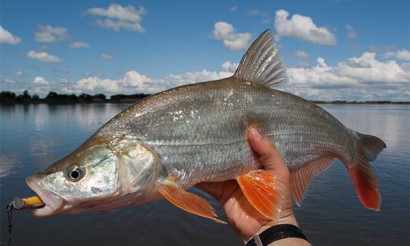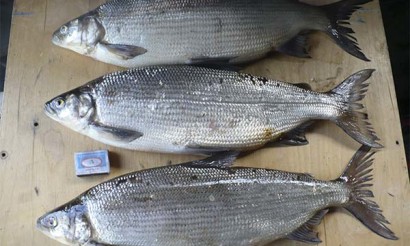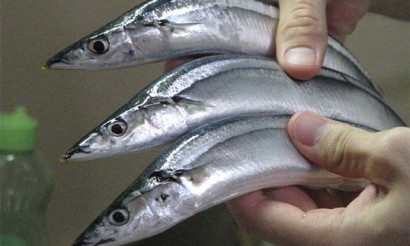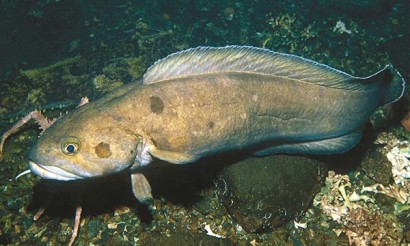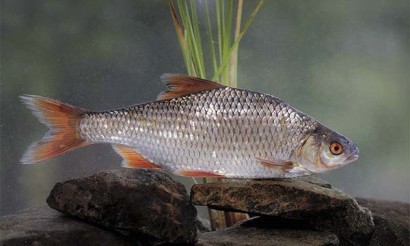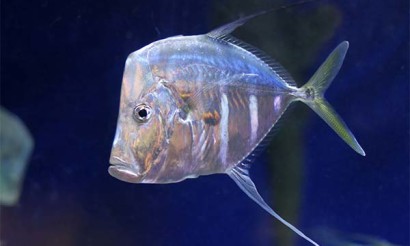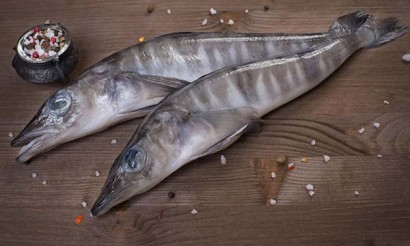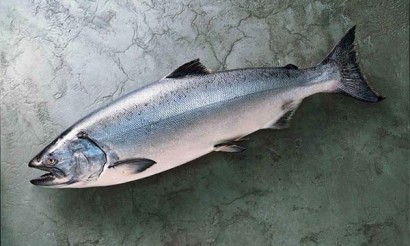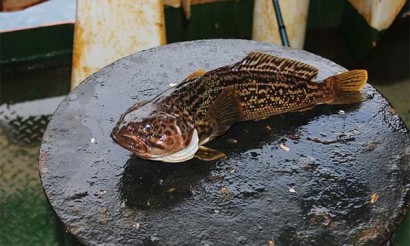Khamsa fish: useful properties, how to cook it, what makes it different from sprat
This wonderful fish is very often confused with sprat and anchovy. This is completely wrong! Yes, they are similar in appearance, but the taste characteristics of each fish are individual. We propose to understand what is the difference between khamsa and other small fish.
- Khamsa: what kind of fish it is
- Types
- How it looks
- Where does it live?
- What it tastes like
- Hams and sprat: what's the difference?
- Composition and calories
- What is useful for khamsa meat
- General benefits
- For Women
- For Men
- In Pregnancy
- For breastfeeding
- Can I Give to Children
- Can I Eat Hamsa to Lose Weight
- Health Hazards and Contraindications
- How to choose and store
- Salted Khamsa: Benefits and Harms
- How to Pickle "Khamsu" at Home
- Dry Salting
- In Brine
- Spicy Salting
- Salting with Lemon
- How to cook Khamsu: Recipes
- In the pan
- In the oven
- Khamsa Salad Recipe
- How to Make Chops of Khamsa
- Q-answer
- Are there many bones in the fish?
- How to peel khamsa?
- How and with what do you eat anchovies?
- Interesting Facts
Khamsa: what kind of fish it is
The fish lives on the coast, exclusively in flocks. The main place of residence is the Atlantic Ocean, it swims in its eastern part. In addition, khamsu can be found in the Mediterranean and Black Sea. During the summertime, it often swims in the Baltic Sea, the North Sea and the Sea of Azov.
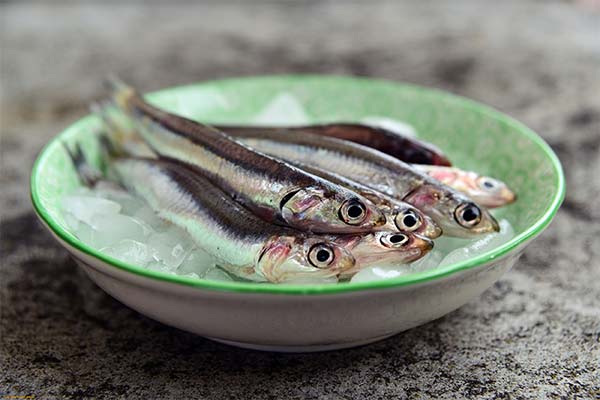
Mankind has been familiar with this fish for a long time. At some time, khamsa was compared to bread, because they ate it quite often.
Types
Due to the fact that the habitat of khamsa is quite extensive, it was divided into some subspecies:
Black Sea
Black Sea khamsa is the most common. It is in the Black Sea that this fish grows to a length of about 11 centimeters. This is an average figure in terms of size. The Black Sea khamsa is a subspecies of the European anchovy. The permanent habitat of this species of khamsa is the Black Sea. During the warm season the flock spreads out all over the upper surface of the sea. During the summer months it can be seen in the northwestern part, as at this time there is a huge amount of plankton, which this fish feeds on. And it is there that the optimum temperature regime for small fish species is observed. Khams are a common inhabitant of the Black Sea, which is why predators such as mackerel, petrels, gulls, dolphins, etc. like to eat them.
Atlantic
The Atlantic hamster is the largest, capable of reaching 20 centimeters in length.
Azov .
Is the opposite of the previous species. In the Sea of Azov fish can grow to only 10-12 cm. This type of khamsa lives in these waters only in the summer. It is a subspecies of the European anchovy, but differs significantly from the Black Sea in two ways:
- Sea of Azov fish is lighter in color than Black Sea fish.
- The most important difference is considered to be the size of fish; Azov fish is many times smaller than Black Sea fish.
Mediterranean .
Mediterranean khamsa reaches the average size. In general, she grows to 12-15 centimeters.
How it looks like
Externally, everyone knows this fish, but very often it is confused with an ordinary sprat. The first significant difference is that the corner of the khamsa's mouth ends further back than the eyes, but few people notice such a small error. It is for this reason that the distinction between these fish must be marked:
- Khamsa are not capable of growing more than 20 centimeters in length. This length is found only in the Atlantic species, and in general it grows to 12-17 centimeters. In addition, attentive people are able to note that khamsa has no ventral keel and lateral line.
- The back of khamsa has a greenish tint, and the abdomen is light silvery. The sides have a bright silver color.
- Khamsa lives in waters at a positive temperature of 5-28 degrees Celsius. At this temperature, the fish swims on the surface of the water. During the winter seasons, the European anchovy retreats to the depths. In the Mediterranean Sea, khamsa goes to a depth of 200 meters, and in the Black Sea - to a depth of 70 meters.
- There are 13 rays in the dorsal fin.
- The khamsa has 43-47 vertebrae.
- The number of gill stamens reaches 70 pieces.
Khamsa size depends directly on its subspecies and habitat. The largest representatives are the Mediterranean and Atlantic, their length is 19-20 centimeters. The smallest fish would be Azov, it can only reach 12 centimeters. The other species have an average length of 12-17.
Among the subspecies, the difference is visible not only in size, but also in color. The Black Sea khamsa has a bluish-black back, and the Atlantic khamsa has a reddish hue.
Where does it live
Khamsa lives in the Atlantic and Indian Oceans, as well as in the seas: Black, Mediterranean, Azov and Baltic. The main catching ground in Russia is the Black Sea, and in Europe - the Mediterranean.
If we take the Russian khamsa, we can definitely say that it inhabits the Black Sea. During cold weather, the fish migrates and resides near Sevastopol and Alushta. Eastern flocks winter on the shores of Georgia, Tuapse, and there is a noticeable increase in their numbers near Novorossiysk. During the winter, the fish try not to make any maneuvers.
What does it taste like?
Khamsa has been known for a very long time, in ancient times the Romans and Greeks bought this fish from Crimean fishermen. She was very valuable, and inferior in value only to the bread. Black Sea khamsa is always characterized by a soft pink color of meat. It tasted tender and had a slight bitterness. The fish is very small and can be eaten whole. The bones are soft and small, which allows you to eat it without fear. It is not only convenient, but also useful. It is in the skin and bones of this fish contains a large number of useful properties.
Khamsa and sprat: what is the difference?
The main difference between khamsa and sprat is that the former has a corner of its mouth that goes behind the back of the eye. In addition, khamsa is not able to grow more than 20 centimeters. These fish varieties differ in color: Khamsa has a greenish back, a bright-silver color of the body, and the abdomen is silver-white.
Composition and calories
One serving of fish is able to saturate the human body with essential amino acids. Khams contain the same:
- Fat-soluble and water-soluble vitamins.
- Macronutrients and trace elements: potassium, magnesium, zinc, calcium, sodium, fluorine, chromium, phosphorus, sulfur, iodine and iron.
- Fatty acids and omega-3's.
- Amino acids that cannot be replaced by anything else: taurine, lysine, methionine and tryptophan.
Khamsa is considered a fatty fish. Its caloric value per 100 grams of product is 88 kilocalories. Of these, 4.1 grams of fat and 17.6 grams of protein. It does not contain carbohydrates, like all fish.
What is the usefulness of khamsa meat
The meat of khamsa is very useful to eat, because it has many nutrients. These substances have a beneficial effect on the overall health of the person.
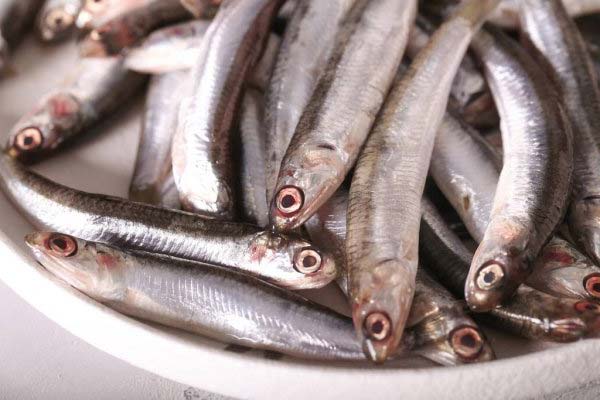
General benefits
European anchovy has a long list of health benefits:
- Due to its high calcium and phosphorus content, anchovy promotes stronger nails, bones, teeth and hair, as well as proper muscle development and function.
- Due to the high content of vitamin F, the skin becomes healthier and itching due to various diseases is reduced.
- A large list of vitamins helps to improve brain activity, thereby preventing the occurrence of atherosclerosis.
- Vitamins, macro-and micronutrients, amino acids contribute to the prevention of angina and blood clots, in addition, they resist the appearance of cardiovascular disease.
- In case of thyroid gland diseases it is desirable to eat khamsu as often as possible, and the condition will noticeably improve.
- Due to fat-soluble vitamins, skin condition and cell regeneration will improve.
- Hams can easily replace pork and beef in the human diet, as they have easily digestible proteins.
- The omega-3 fatty acids contained in this fish help improve brain activity, strengthen the memory and accelerate thinking processes.
- The large amount of amino acids in combination with zinc and vitamins helps to improve the male reproductive system.
For women
Hams may seem like a fatty fish, but it is not so. Yes, there is a lot of fat in its composition, and it is considered caloric. The fact is that all the fats present in it are unsaturated. Consequently, they are not able to cause any harm to the body, but rather the opposite. Unsaturated fatty acids help the cardiovascular system. This product can be safely used during the diet.
Hams can improve the condition of the skin, hair, teeth and nails, which is a huge advantage for the fair sex.
For men
For men, this fish is a treasure trove of vitamins. Thanks to its composition, it can strengthen bones and muscles. In addition, certain vitamins and amino acids have a beneficial effect on potency, which is important at any age.
When pregnant
There is a perception that pregnant women can not eat khamsa at all and in any form. In fact, this fish can and should be eaten during pregnancy. Khamsa has a long list of vitamins, amino acids and all sorts of useful properties. It will in no way harm the baby in the womb, but rather the opposite - will help in its development. The only thing is that you should not eat a very large amount of salted and smoked khamsa, as salt can retain water in the body, which can cause swelling.
Important! Pregnant women should not eat this fish more than twice a week.
When breastfeeding
During breastfeeding, as well as during pregnancy, you should include khamsa in your daily ration. Breast milk will pass on to baby all the useful properties of the seafood. Thanks to khamsa baby in the womb will receive all the vital elements that will strengthen and develop healthy bones, nervous system and many other important processes of the human body.
Can we give it to children?
There is a definite answer to this question - yes! After the age of two, you can give children fish, starting with small portions. This will allow the child to receive all the necessary vitamins and minerals for its full development. But note that European anchovies should preferably be served steamed. Salty, fried or smoked khamsa should not be given not only to children, but also to adults.
Is it possible to eat khamsu when losing weight?
Yes, khamsu can be consumed during diets. The fact is that although it is considered a rather fatty fish, the fats are unsaturated. There are many different diets, which include this fish. The only difference is the method of cooking, as fried khamsu should by no means be eaten when losing weight, as well as salted. It is fried and salty food that is harmful to the body.
Harm and contraindications
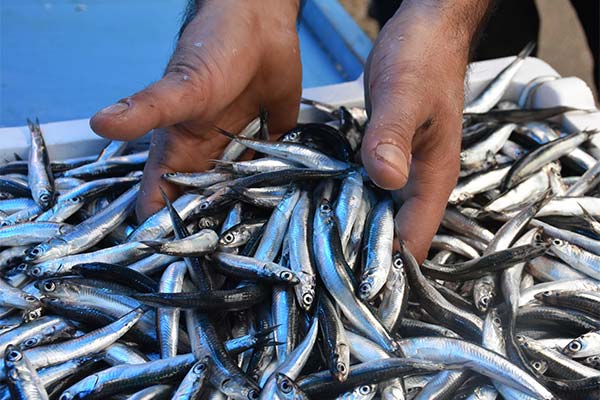
- The use of khamsa in food is prohibited only to those people who have an intolerance to seafood and fish. It is not worth to eat it (at least in large quantities) to people who are prone to food allergies. The fact is that any fish can be an allergen.
- In addition, you should not abuse the use of khamsa for people who have problems with gastrointestinal tract. This fish can be eaten during diets, but it is still considered greasy. This is especially true for salted and fried khamsa.
- Hams should never be eaten raw. The fact is that this fish belongs to the anchovy family. It is this family is particularly strongly infected with parasites - nematodes. Before eating khamsa, be sure to treat it well with heat methods.
Despite these contraindications, this fish is recommended for children, pregnant women and women who are breastfeeding. The thing is that the life span of khamsa is no more than four years. Thanks to such a short life span this fish does not accumulate heavy metals such as mercury and all its various components.
European anchovy can have excessive amounts of sodium. If you have high blood pressure, you should consider this factor. To reduce the amount of sodium in canned anchovy, you need to drain the liquid from it and rinse it carefully. In such a case, eat it in moderate quantities.
If the purchased khamsa was fresh, then before cooking the fish should be thoroughly cooked, or frozen. Thanks to these actions you will kill all kinds of parasites.
How to choose and store
When choosing a khamsa, you should take into account some features of this fish. First of all, it is important to know the season of fishing. Khamsa is caught only from October to March. It is at this time you can buy fresh fish. At any other time you can fall prey to poachers or swindlers, who pass off defrosted fish as fresh.
Look closely at the fish, it should be without cuts and holes. If there are these signs, you should not take the seafood. The eyes of khamsa should be clear, with no signs of clouding. The smell should be pleasant and fishy, without any signs of mustiness and decay.
Fresh fish should be stored in a cold place for no more than three days. Frozen product can be stored for six months.
Salted khamsa: benefits and harms
Salted khamsa can bring significant benefits as well as significant harm to the body. The fact is that salted seafood has vitamins, macro- and microelements and amino acids, but their content is much lower than in fresh fish. Its important advantage is that it has a large amount of easily digestible protein. Because of this khamsa is able to replace the use of its own composition of beef and pork. The negative impact of the consumption of salted khamsa is observed because of the large amount of salt. Especially it can be dangerous for people with gastrointestinal problems and kidney disease. You should not eat such a product and those who are on a diet.
How to salt khamsa at home
Everyone loves to eat potatoes with delicious salted fish. Khamsa is especially delicious because it does not need to be cleaned at all! It can be purchased ready-made, or you can buy fresh, and salt it yourself. There are several delicious options for salting this fish - we will describe them here.
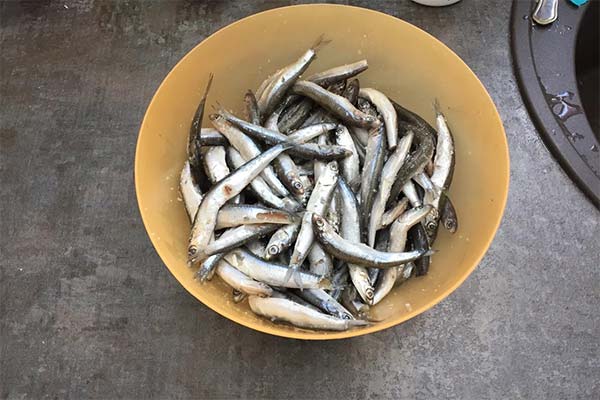
There are different variations of salting fish: dry, in brine and spicy. The resulting taste differs slightly from each other, but each of them is insanely delicious.
Dry salting
This option is the simplest, but this does not mean that the resulting fish should not taste good. This type of salting only requires you to fill it with salt and leave it alone for a few hours.
You need to take a clean and absolutely dry container (or a large basin), any, even enameled. In it, put the fish, not too thick. Pour coarse salt on top, the main rule - it should not be iodized. Mix the fish thoroughly. The salt should envelop each fish, but the layer should not be too thick. Put the dish in a cold place for about 3 hours. After the specified time, the salted fish will be ready. Before serving, do not forget to rinse it thoroughly from the remaining salt.
In brine
When pickling khamsa with the help of brine, it turns out especially tender and juicy. Most fans of fish use this version of cooking.
If khamsa is frozen, then it should be completely defrosted, and at this time you can safely deal with the brine. It is important to note that to pickle anything, do not use iodized salt and extra salt!
For the brine take: one liter of water, one cup of salt, one tablespoon of sugar.
We put the water on the fire and let it boil. After boiling, you can add salt and sugar and mix it thoroughly until it dissolves. The brine is ready, now it's time to let it cool. Next, the fish is washed under running water, and then laid in a pan (whole, without tearing off the head, etc.). The brine should cover the fish completely! On top of it, it is desirable to put something for weight (many put a plate or saucer). Now put the pan with the fish in the refrigerator. Depending on what degree of saltiness you want to get, for how long you leave it alone. It should be borne in mind that after 12 hours the khamsa acquires a medium degree of saltiness. If you want to get slightly salted fish, you should leave it for no more than 10 hours. If you want a saltier fish, then about one day.
After salting it, you just need to wash the fish with cool water, then tear off the heads and, pouring oil on it, enjoy.
Spicy pickling
For this kind of salting it is necessary to take: one kilogram khamsa and fill it with 150 grams of salt, add two teaspoons of your favorite spices, and then mix it thoroughly. After that, cover the fish with weights and leave it in a cold place for two days. Before serving, rinse the fish, and it is ready to eat.
Pickling with lemon
This method helps to salt fish quickly and deliciously. You need to take a kilogram of khamsa, add 400 grams of salt and 30 grams of sugar. After that, add the juice of one lemon and mix everything thoroughly. Leave it at room temperature for half an hour. As the specified time comes out, move all the fish into a bag and place it in the refrigerator for an hour and a half. After the time has passed, take out the khamsa and rinse thoroughly. Then you can serve it to the table.
This fish is now not only healthy, but also insanely delicious!
How to cook khamsa: Recipes
Khamsa is delicious and useful in any cooking, but there are especially delicious recipes with this small fish.
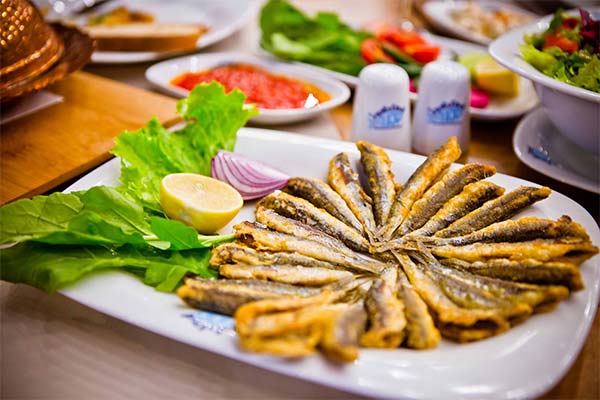
In the pan
Fried khamsa according to the Turkish recipe:
You will need:
- 200 grams of khamsa;
- corn flour;
- vegetable oil;
- 1 tomato;
- 1 bun;
- 1 lemon;
- 2 garlic cloves;
- rosemary sprig;
- 1 chili pepper;
- 1 onion;
- lettuce leaves;
- salt.
Preparation:
- Take freshly frozen hams and defrost.
- After complete defrosting, clean the fish from the head, backbone and innards.
- Put the khamsa meat into a bowl and add the spices described above.
- Then roll the fish in corn flour and fry until golden crust.
- Cut the bun and add the fried fish, tomato, lettuce and onion.
- You can also add all kinds of your favorite ingredients inside the bun.
- You can add ground pepper and salt if desired.
- Once all the ingredients are inside, sprinkle the contents with lemon juice and enjoy a wonderful meal!
In the oven
Fish casserole.
You will need:
- 1200 grams of khamsa;
- half a kilogram of spinach;
- ¾ cup grated favorite cheese;
- medium onion;
- 3 garlic cloves;
- 2 chicken eggs;
- breadcrumbs;
- sunflower oil;
- Italian or provincial herbs;
- ground black pepper;
- salt.
How to Prepare:
- Wash the fish, remove the heads and innards, then rinse again.
- Peel the onion, finely chop, fry until tender. Finely chop the garlic and stir-fry with the onion for a minute.
- Add spinach and fry all together until soft. Toss the entire contents in a colander and squeeze well to drain all the juice.
- Take the form in which we will bake the fish, and grease it with oil.
- Put half the fish in the dish, backs side down.
- Mix the spinach, onion and garlic with the cheese and egg. Mix and season with salt and pepper.
- Place the spinach mixture in an even layer on top of the fish.
- On top of the spinach lay the remaining half of the khamsa with the backs facing up.
- Grease everything with butter and sprinkle with breadcrumbs.
- Bake in oven at 180 degrees Celsius for 40-50 minutes.
Recipe for khamsa salad
You will need:
- potatoes - 400 grams;
- slightly salted khamsa - 200 grams;
- green peas - 200 grams;
- Fresh cucumber - 200 grams;
- green onion
- sunflower oil;
- salt;
- allspice and black pepper.
Recipe:
- Boil the potatoes in jacket.
- After the potatoes are boiled, peel them and cut into small cubes.
- Clean the khamsa from the head, innards, fins and tails. Wash the meat well and cut it into about the same cubes as the potatoes.
- Cucumber is washed and cut into identical cubes.
- Finely chop green onions.
- Open peas, drain the water, add them to the rest of the ingredients.
- Pour oil over everything, salt and pepper and mix thoroughly.
- Before serving, let the salad leave for 15 minutes.
How to make cutlets of khamsa
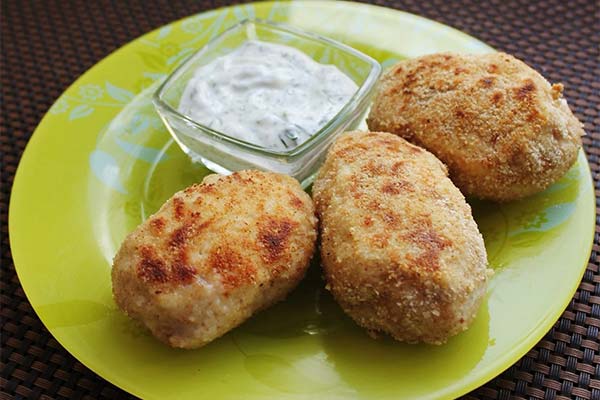
You will need:
- half a kilogram of salted khamsa;
- 3 chicken eggs;
- 3 tablespoons of flour;
- 40 grams of green onions;
- sunflower oil;
- ground black pepper.
Preparation:
- Remove the heads, tails and fins from the khums.
- Clean out all the insides, including the backbone (it is not necessary to get rid of it, since the fish is to be finely sliced).
- Rinse under running water and finely chop.
- Shred the green onion and send it to the fish pieces.
- In a separate bowl, beat three chicken eggs.
- After beating, add the eggs to the fish and onions.
- Also in a bowl add flour and pepper, salt as needed. Mix everything thoroughly.
- Heat a frying pan, grease with oil.
- Scraps (cutlets) lay out with a spoon on a heated frying pan and fry to a beautiful golden crust.
Such cutlets can be served with your favorite sauce or vegetables.
Q&A
Are there many bones in the fish?
Hams have a lot of bones, but all of them are small and not sharp. Even the backbone, which in principle should be tough, is not. This fish can be safely enjoyed without fear of damage to the mouth and throat area with bones.
How to clean khamsa?
This fish has small, non-sharp bones, which is why it is not necessary to clean it at all. But if you suddenly wish to eat clean meat, it is quite easy and simple to do. Rip off the head and clean the insides of the belly, and then the fish should be thoroughly washed. You can get rid of the bones by taking out the backbone, and the rib bones will almost all come out behind the backbone.
How and with what do you eat anchovies?
You can eat anchovies any way you want. For example, you can remove the head and eat the rest, or you can eat it whole or clean it and enjoy the excellent meat. This fish is mostly eaten with potatoes, but you can also serve it with all kinds of vegetables, and even as a separate dish.
Interesting Facts
- Lumpfish reproduces through spawning. The fish is ready for reproduction one year after birth. Spawning takes place in the summer period (June and July).
- During one pregnancy, the hamster is capable of laying about 25,000 eggs, but it does not happen at once, but four times in a row, with a small break.
- Already in October, the shoals gather in shoals and arrive closer to the shore for wintering.
- Khamsa is so popular that in 2017 a monument to this little fish was erected on the Black Sea coast.
«Important: All information on this site is provided for informational purposes only purposes only. Before applying any recommendations, please consult with a specialized specialist. Neither the editors nor the authors shall be liable for any possible harm caused by materials."

